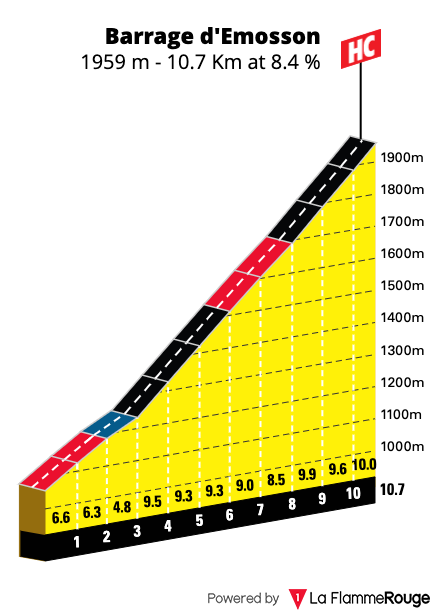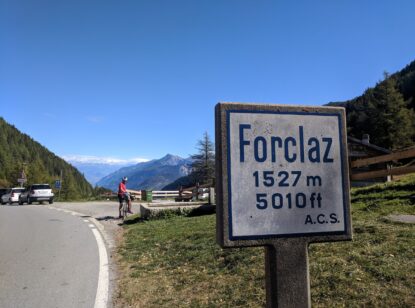A Guide to Cycling Lac d’Emosson
The climb to Lac d’Emosson is located in the Swiss Alps near the French border. It is rated as an Hors Categorie climb and from the village of Le Châtelard, the average gradient is 8.4%. Ascending 916m / 3005ft over a distance of 10.7kms / 6.7mi. the road to the summit is very challenging. It featured as a mountain top finish in the 2016 edition of the Tour de France with Ilnur Zakarin taking first place. At the summit of the climb, you will reach the barrage d’Emosson (dam wall) and be greeted with a stunning mountain vista.
Lac d’Emosson Climb Statistics and gradient profile

Length: 10.7km / 6.7mi
Average gradient: 8.4%
Start point: 1,120m / 3,675ft
Elevation at top: 1959m / 6,427ft
Category: Hors Categorie
Lac d’Emosson Cycling Route
Ride distance: 64 km / 40mi
Elevation gain: 1,830m / 6,003ft
Nearest town: Le Châtelard
Facilities at top: Yes
When to ride: May to October
Road condition: Good – Asphalt
Nearest climb: Col des Montets
Number of approaches: 1
Through road at top: No
A Gentle Start With the Col des Montets Climb
This cycling route to Lac d’Emosson begins in Chamonix however if you are staying elsewhere in the Chamonix Valley you can easily amend the starting location to suit. The first 11kms are all uphill as you tackle the climb of the Col des Montets. This mountain pass serves as a good warm-up and the gradient is quite gentle throughout with an average under 4%. Views of the Mont Blanc Range and glaciers are a highlight and serve as a good distraction here. Once at the top of the summit you will then continue downhill for 8kms. Passing through the French/Swiss border you will then take a left turn directing you through the village of Le Châtelard. It is here that the climb of the Lac d’Emosson begins. If necessary fill up your water bottles (there is a public fountain a few km into the climb at Finhault) as the road ahead is far steeper than that of the Montets and will be a real test of your legs.
Lac d’Emosson Climb
At 10.7km in length and with an average gradient of 8.4% you will really need to settle into a good climbing rhythm early. The first 3kms of the climb are at a shallower gradient which will allow your legs to get used to climbing again after enjoying the descent of the Col des Montets. Of course an easier gradient for so long at the start of the climb does mean that the gradients for the remainder will be quite a lot harsher. Once through the village of Finhault the gradient remains in double digits to the top – often hovering close to 11%. As you near the summit you will negotiate some switchbacks on the climb. It is around these hairpin bends the gradient eases slightly so you have an opportunity to enjoy some respite by taking a wider line through the corner.
Quiet Roads Despite the Tourist Crowds
Despite the popularity of this area, the road to the summit is surprisingly quiet and there is little motorized traffic. This is owing to the popular Vertic Alp Panoramic Train and Funicular which takes tourists to the summit from Le Châtelard. The Funicular reaches gradients of 87%! Hence in the summer months whilst there is a distinct lack of cars on the road, it is quite common for there to be lots of people at the lake itself. At the summit, there is also a cafe where you can top up on food and water whilst taking in the snowcapped peaks which frame the lake beautifully. It is possible to continue on further to another dam which is higher up still. The road which leads to the top is steeper than that which you have cycled already and it will make progress feel extremely slow. No doubt you will enjoy that downhill all the way back to the base of the Lac d’Emosson climb.
Return to Chamonix via the other side of Col des Montets
After the descent, it is time to return to climbing once more for the final test of this cycling route as you tackle the other side of the Col des Montets. This side of the climb is shorter than the side from Chamonix. The average gradient is slightly steeper but compared to that of Lac d’Emosson it will feel like a dream. The road surface is smooth and you will be able to settle into a good climbing rhythm. The familiar summit will feel that much nicer as you can enjoy the final 11km downhill run back down the Chamonix Valley – with views of Mont Blanc as well.
Other cycling climbs near Lac d’Emosson
It is possible to add even more climbing to this route by adding in an ascent of the Col de la Forclaz. We have listed the details of the climb below for you to consider. A further variation to the route would be to take on the shallower ascent of the Forclaz (from Le Châtelard) before descending to the Swiss town of Martigny. From here you can choose to take the Mont Blanc Express train all the way back to your starting location in Chamonix. Bikes are allowed on the train but you will be required to book them when you purchase your ticket. The trains run regularly throughout the day and the journey takes 90minutes. This would make for quite a memorable ride experience. We would recommend pre-booking your tickets in Chamonix if you are contemplating this option. More information about the train is available here.
Col de la Forclaz
The Col de la Forclaz climb connects the Swiss town of Martigny to the small village of Le Châtelard. From Martigny, the road to the summit is classified as an Hors Categorie climb, and over 13.7km the gradient averages 8%. This northern approach of the climb is the most difficult. Alternatively from La Châtelard, the gradient averages 6% for 7kms. Discover this mountain pass here.


Col des Montets
As mentioned in the ride report If you are cycling to Lac d’Emosson via Chamonix then you will first need to ride over the pass of the Col des Montets. This pass serves as a good gentle warm-up before tackling the harder Hors Categorie Climb of Lac d’Emosson itself. You can read more about the Col des Montets cycling climb here.
Plan your cycling holiday to the Chamonix Valley
If you are not familiar with the Chamonix Valley, our comprehensive guide will help you plan everything you need for your cycling holiday. The guide includes information such as:
- a map of the Chamonix Valley with climbs and towns marked
- where to base yourself depending on which mountains you would like to ride
- cycling hotels and lodges
- bike hire outlets
- getting to and from the Chamonix Valley
- non-cycling attractions and activities in the region
